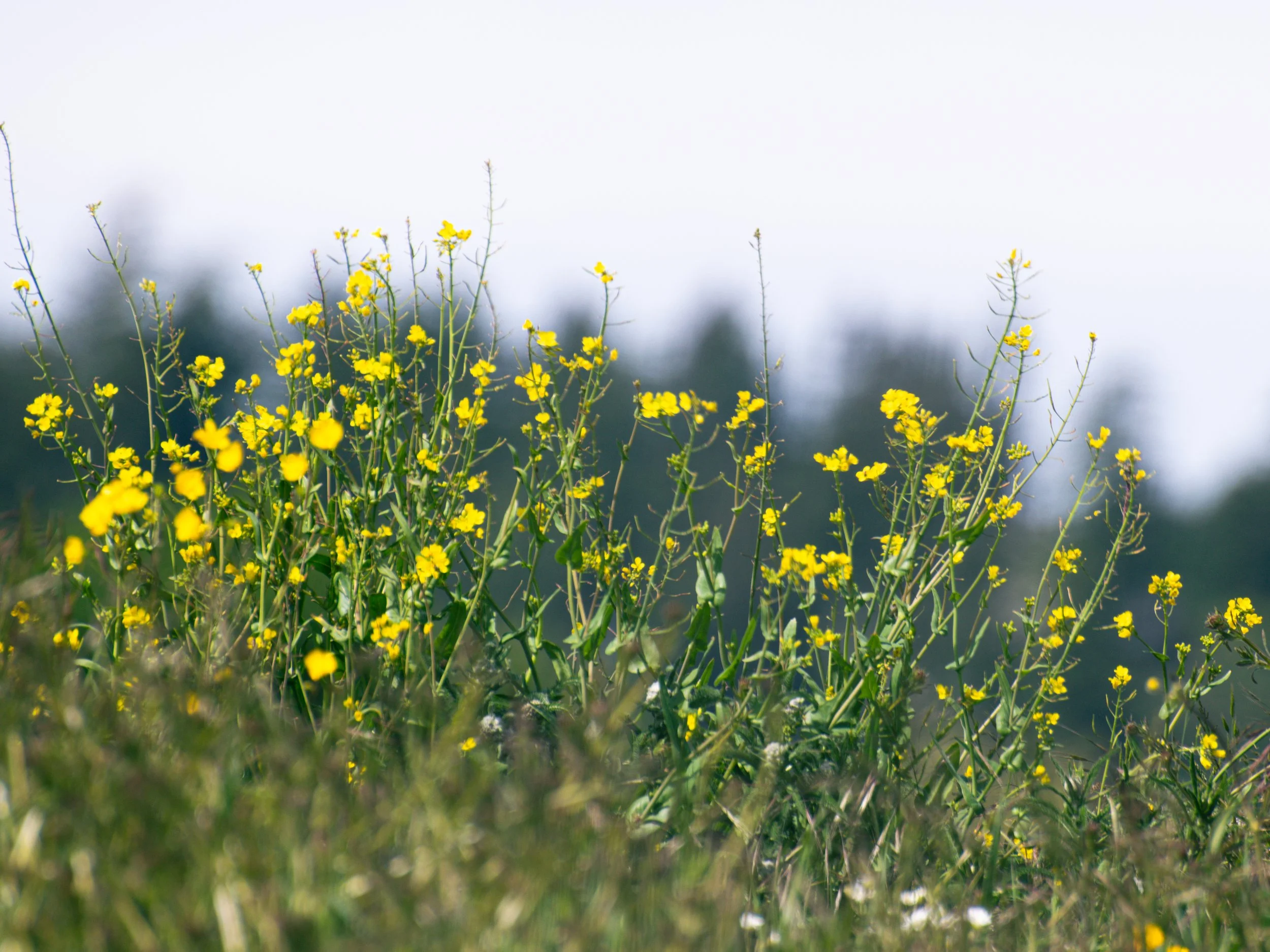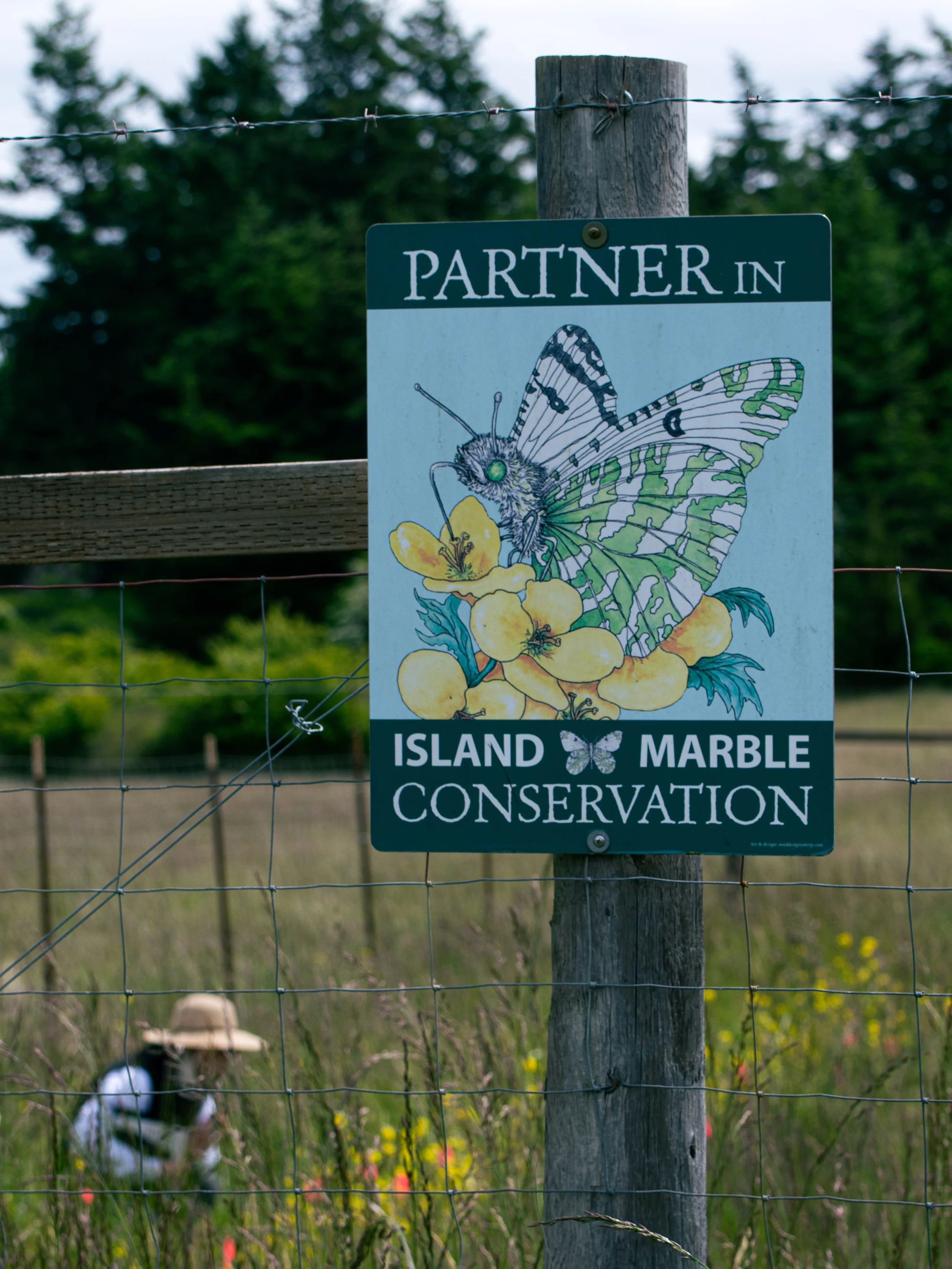Back From The Brink
Efforts underway to preserve the endangered Island Marble butterfly
Island marble butterfly resting on a golden flower. // Photo courtesy of Karen Reagan with U.S. Fish and Wildlife Service
Photo Essay by Sophia Jellinghaus
July 7, 2025
On the southern tip of San Juan Island, a butterfly glides over the grassy prairie. Its green and white wings flutter as it flits from flower to flower, leaving behind tiny orange eggs.
Field mustard, a flowering shrub, the island marble uses as a host plant.
A butterfly laying eggs may seem like a common springtime sight, but this is a very uncommon butterfly.
The Island Marble butterfly, or Euchloe ausonides insulanus, is endemic to the coastal prairie that was once common in the Salish Sea ecoregion. With an estimated population of under 500 today, the species only exists on San Juan Island.
Adult island marble sightings are rare not only because of the species’ depleted population, but also due to their uncommonly long metamorphosis period, which often lasts up to 11 months. Once they emerge from their chrysalises in the spring, each butterfly only lives about a week in their adult reproductive stage.
In progress habitat restoration site at the San Juan Preservation Trust.
“I myself have never actually seen an adult Island Marble,” Liz Doane, the San Juan Preservation Trust’s education specialist, said. “That's still on my bucket list. I've seen the eggs, but they are that fleeting.”
The butterfly will only lay eggs on its host plants, a few species of flowering mustards. These host plants have evolved to prefer the nutrient-poor prairie soil. However, only 3% of the Salish prairie land that existed a few hundred years ago in Western Washington remains. In the past 4,000 years, the once warm and dry climate that supported Salish prairie has become cooler and wetter, making it more difficult for the prairie to compete against growing forests.
“The only reason prairies survived is that the native peoples of the region were engaging in agriculture, engaging in controlled burning,” Emily Bradford, a graduate student researching Island Marble butterfly habitat at Western Washington University, said. “By doing that, they maintained these prairies and prevented the ecotype from going extinct.”
Preservation Trust volunteer painstakingly searching field mustard for Island Marble eggs and marking them with orange flags for further observation.
Today, the butterfly’s prairie habitat has degraded from the effects of colonization, as farmland and invasive woody plants replaced open grassland. Now, both the butterfly and its ecosystem depend on the efforts of passionate conservationists.
Vibrant field mustard flower, a popular spot for Island Marble to lay their eggs.
While groups like the National Park Service cultivate hands-on captive rearing programs to make sure butterfly specimens make it from egg to adulthood, the San Juan Preservation Trust takes a different approach, centered around land acquisition and volunteer work.
The San Juan Preservation Trust is an organization dedicated to the stewardship and preservation of land on the island. They use a combination of land preserves and conservation easements. The land preserves are owned by the trust, and conservation easements are stewardship agreements with landowners, creating more suitable habitat patches outside of the butterflies’ established range in South San Juan.
“If they feel like getting adventurous, exploring and finding a new place, or if they get a little wind-pushed and [are] pushed too far, they've got a place to land,” Doane said. “Hopefully, that will encourage them to break out of their one spot.”
The Island Marble is native to the prairie on the southern side of the island making it a crucial environment to protect.
Trust members and volunteers plant the habitat patches with field mustard, or Brassica rapa, and other plants that support a healthy prairie, like field chickweed and Roemer’s fescue. Though field mustard is a non-native agricultural plant, the butterfly has accepted it as one of its host plants, and its tendency to grow well in a variety of environments is helpful in Island Marble conservation work.
Two native mustards still exist on San Juan that are viable host plants, but the Virginia pepperweed’s preference for sandy soil and the tower mustard’s scarcity make field mustard the most realistic option, at least for now.
A similar insect often confused for the Island Marble, while they may look the same at first glance they are in reality very different.
“The plan is to, once [Island Marble butterfly] numbers start becoming more abundant, see if we can propagate what their native species were and then eventually phase out the Brassica,” Kathleen Foley Lewis, San Juan Preservation Trust’s director of special projects, said.
Currently, the trust is using two different layouts for its habitat patches on San Juan Island. The Sunstrom and Frazer preserves set up patches in garden-like rows, while the patch at Phelps is being grown on man-made dirt mounds.
The Phelps patch retains a significant amount of water, so traditional garden rows create poor conditions for the plants. Instead, Lewis used an excavator to create three mounds of topsoil followed by seedings of Brassica, according to Doane.
Volunteer placing orange flags near Island Marble eggs in a gated area labeled with an Island Marble Conservation sign.
As recently as 2024, the National Park Service estimated that less than 5% of Island Marble eggs survive to adulthood each year. Deer grazing and human or dog disturbance are among the most common threats to vulnerable eggs, caterpillars and chrysalises.
For the habitat patches, this means fencing and careful tending are non-negotiable.
However, at the Phelps preserve, preparation is underway for an unfenced 8-acre island marble habitat area, which is significantly larger than any of the trust’s existing habitat patches.
Although the trust can control human and dog traffic, deer grazing is still a concern.
“We're going to put a trail cam up to monitor deer use,” Lewis said. “If we find that it's becoming a big problem and a lot of our plants are getting munched, we’re going to open the preserve up for deer hunting.”
As the trust plans for this new expansion, their hard work seems to be paying off.
Adult Island Marbles have occupied both their Frazer and Phelps preserves in the past and are laying lots of eggs at Frazer this season.
Bradford’s thesis is focused on mapping areas where the island marble could survive outside San Juan Island. She uses GIS technology to identify butterfly-compatible areas by comparing past Island Marble sightings, climate and land data.
“There's a lot of suitable areas on Lopez Island, Whidbey Island, some in Clallam County,” Bradford said. “It's going to be easier for us to try to conserve this habitat than it is to actually go out and create new habitat via active restoration.”
Though the Island Marble is still a rarity in the only place it calls home, the hard work and foresight of today’s conservationists may be enough to bring the butterfly back from the brink.
Only time will tell.








